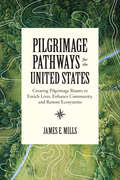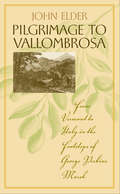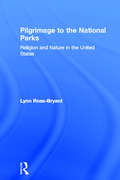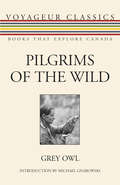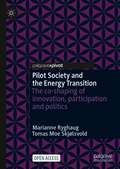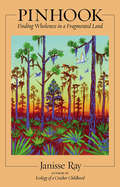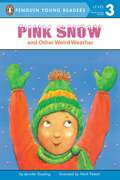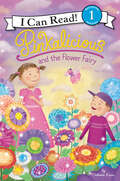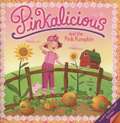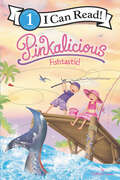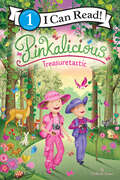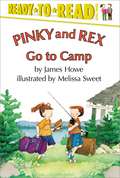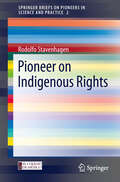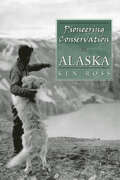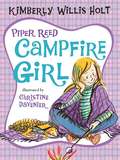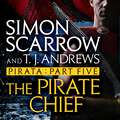- Table View
- List View
Pilgrimage Pathways for the United States: Creating Pilgrimage Routes to Enrich Lives, Enhance Community, and Restore Ecosystems
by James E. MillsAn inspirational argument for the creation of a new pilgrimage tradition in the United States.Pilgrimage is a sacred tradition that has existed around the world for centuries. Every year, more than one hundred million devotees from different cultures and faiths embark on journeys to such holy sites as Santiago de Compostela, Mecca, and Banaras. For some, making a pilgrimage is a spiritual act, while for others it is a secular experience of personal restoration. And yet there has never existed a tradition of pilgrimage within the United States.Cultural geographer James E. Mills makes a compelling case for the creation of a network of American pilgrimage routes to heal societal divisions and foster a new ethos of humanitarianism and environmentalism. He also addresses practical considerations for the development, ownership, and administration of future routes. Pilgrimage Pathways for the United States is for anyone considering a pilgrimage and for those of us who are interested in connecting and protecting our natural world, including environmentalists, interfaith clergy, political leaders, community developers, and activists.
Pilgrimage to Vallombrosa: From Vermont to Italy in the Footsteps of George Perkins Marsh (Under the Sign of Nature: Explorations in Ecocriticism)
by John Elder"Set aside your Bella Tuscanys and Year in Provences for a different kind of travel book. Pilgrimage to Vallombrosa puts a walking stick in your hand and Marsh's Man and Nature in your knapsack, exploring how Italians have managed their natural and cultural heritage in ways that sustain both. John Elder's poetic meditations on land and life demonstrate that only by searching beyond our familiar boundaries can we discover better ways of living back at home."--Marcus Hall, author of Earth Repair: A Transatlantic History of Environmental Restoration "This collaboration--between George Perkins Marsh and John Elder, between Vermont and Italy, between maple and olive--is one of the smartest, soundest, deepest books about the relationship between people and nature that I've ever read. It will be a classic."--Bill McKibben, author of The End of Nature "Elder's impassioned pilgrimage shows us how to delight in messy wilderness, to secure a curative habitation of the world, and, with Marsh, to lend ecological nous to our gravest task: knowing ourselves and respecting one another. Let the maple seeds and olive stones of Elder's visionary harvest restore to us a reflective and redemptory future."--from the foreword by David LowenthalThe pivotal figure in Pilgrimage to Vallombrosa is the nineteenth-century diplomat and writer George Perkins Marsh, generally regarded as America's first environmentalist. Like Elder, Marsh was a Vermonter, and his diplomatic career took him for some years to Italy, where, witnessing the ecological devastation wrought upon the landscape by runaway deforestation and the plundering of other natural resources, he was moved to produce his famous manifesto, Man and Nature. Marsh drew parallels between the despoiled Italian environment and his home landscape of Vermont, warning that the latter was vulnerable to ecological woes of a similar magnitude if not carefully maintained and protected. In short, his was a prescient voice for stewardship. Elder follows in Marsh's footsteps along a trajectory running from Vermont to Italy, and at length fetches up at the managed forest of Vallombrosa. Punctuated throughout with learned and genial considerations of the poetry of Wordsworth, Basho, Dante, and Frost, Elder's narrative takes up issues of sustainability as practiced locally, reports on family doings, and returns finally--as did Marsh's--to Vermont, where he measures traditional stewardship values against more aggressive conservation-oriented measures such as the expansion of wilderness areas. John Elder, Professor of English and Environmental Studies at Middlebury College, is the author of Reading the Mountains of Home and The Frog Run. Under the Sign of Nature: Explorations in Ecocriticism
Pilgrimage to the National Parks: Religion and Nature in the United States (Routledge Studies in Pilgrimage, Religious Travel and Tourism)
by Lynn Ross-BryantNational Parks – ‘America’s Best Idea’ – were from the first seen as sacred sites embodying the God-given specialness of American people and American land, and from the first they were also marked as tourist attractions. The inherent tensions between these two realities ensured the parks would be stages where the country’s conflicting values would be performed and contested. As pilgrimage sites embody the values and beliefs of those who are drawn to them, so Americans could travel to these sacred places to honor, experience, and be restored by the powers that had created the American land and the American enterprise. This book explores the importance of the discourse of nature in American culture, arguing that the attributes and symbolic power that had first been associated with the ‘new world’ and then the ‘frontier’ were embodied in the National Parks. Author Ross-Bryant focuses on National Parks as pilgrimage sites around which a discourse of nature developed and argues the centrality of religion in understanding the dynamics of both the language and the ritual manifestations related to National Parks. Beyond the specific contribution to a richer analysis of the National Parks and their role in understanding nature and religion in the U.S., this volume contributes to the emerging field of ‘religion and the environment,’ larger issues in the study of religion (e.g. cultural events and the spatial element in meaning-making), and the study of non-institutional religion.
Pilgrims of the Vertical: Yosemite Rock Climbers and Nature at Risk
by Joseph E. Taylor Joseph E TaylorFew things suggest rugged individualism as powerfully as the solitary mountaineer testing his or her mettle in the rough country. Yet the long history of wilderness sport complicates this image. In this surprising story of the premier rock-climbing venue in the United States, Pilgrims of the Vertical offers insight into the nature of wilderness adventure. From the founding era of mountain climbing in Victorian Europe to present-day climbing gyms, Pilgrims of the Vertical shows how ever-changing alignments of nature, technology, gender, sport, and consumer culture have shaped climbers’ relations to nature and to each other. Even in Yosemite Valley, a premier site for sporting and environmental culture since the 1800s, elite athletes cannot be entirely disentangled from the many men and women seeking recreation and camaraderie. Following these climbers through time, Joseph Taylor uncovers lessons about the relationship of individuals to groups, sport to society, and nature to culture. He also shows how social and historical contexts influenced adventurers’ choices and experiences, and why some became leading environmental activists—including John Muir, David Brower, and Yvon Chouinard. In a world in which wild nature is increasingly associated with play, and virtuous play with environmental values, Pilgrims of the Vertical explains when and how these ideas developed, and why they became intimately linked to consumerism.
Pilgrims of the Wild
by Grey Owl Michael Gnarowski Hugh EayrsFirst published in 1935, Pilgrims of the Wild is Grey Owl’s autobiographical account of his transition from successful trapper to preservationist. With his Iroquois wife, Anahereo, Grey Owl set out to protect the environment and the endangered beaver. Powerful in its simplicity, Pilgrims of the Wild tells the story of Grey Owl’s life of happy cohabitation with the wild creatures of nature and the healing powers of what he referred to as "the great Northland" of "Over the Hills and Far Away." A bestseller at the time, Pilgrims of the Wild helped establish Grey Owl’s international reputation as a conservationist. His legacy of warnings against the degradations of nature and the dangers of industry live on, despite the posthumous revelation that he wasn’t, in fact, the First Nations man he claimed to be.
Pilot Society and the Energy Transition: The co-shaping of innovation, participation and politics
by Marianne Ryghaug Tomas Moe SkjølsvoldThis open access book examines the role of pilot and demonstration projects as crucial devices for conducting innovation in the context of the energy transition. Bridging literature from sustainability transitions and Science and Technology Studies (STS), it argues that such projects play a crucial role, not only in shaping future energy and mobility systems, but in transforming societies more broadly. Pilot projects constitute socio-technical configurations where imagined future realities are materialized. With this as a backdrop, the book explores pilot projects as political entities, focusing on questions of how they gain their legitimacy, which resources are mobilized in their production, and how they can serve as sites of public participation and the production of energy citizenship. The book argues that such projects too often have a narrow technology focus, and that this is a missed opportunity. The book concludes by critically discussing the potential roles of research and innovation policy in transforming how such projects are configured and conducted.
Pinhook
by Janisse RayJanisse Ray, award winning author of "Ecology of a Cracker Childhood" and "Wild Card Quilt," writes a beautifully evocative paean to wildness and wilderness restoration with an extraordinary journey into southern Georgia's Pinhook Swamp. Pinhook Swamp acts as a vital watershed and wildlife corridor, a link between the great southern wildernesses of Okefenokee Swamp and Osceola National Forest. Together Okefenokee, Osceola, and Pinhook form the largest expanse of protected wild land east of the Mississippi River. This is one of America's last truly wild places, and Pinhook takes us into its heart. Ray comes to know Pinhook intimately as she joins the fight to protect it, spending the night in the swamp, tasting honey made from its flowers, tracking wildlife, and talking to others about their relationship with the swamp. Ray sees Pinhook through the eyes of the people who live there-naturalists, beekeepers, homesteaders, hunters, and locals at the country store. In lyrical, down-home prose
Pink Snow and Other Weird Weather (Penguin Young Readers, Level 3)
by Jennifer DusslingHave you ever seen a hailstone with a turtle frozen inside? Learn all about the weirdest, wackiest, wildest weather ever--and what makes it happen--in this easy-to-read nonfiction reader.
Pinkalicious and the Flower Fairy (I Can Read Level 1)
by Victoria KannCelebrate spring with Pinkalicious! #1 New York Times bestselling author Victoria Kann brings young readers a Pinkalicious I Can Read adventure about flowers and the power of imagination.Pinkalicious is absolutely positive that a flower fairy will visit her garden. After all, flower fairies love pink, and so does Pinkalicious! When Pinkalicious transforms her garden into a pink wonderland, will it entice the flower fairy to visit? Pinkalicious and the Flower Fairy is a Level One I Can Read book, which means it’s perfect for children learning to sound out words and sentences. Whether shared at home or in a classroom, the short sentences, familiar words, and simple concepts of Level One books support success for children eager to start reading on their own.Readers can watch Pinkalicious and Peterrific on the funtastic PBS Kids TV series Pinkalicious & Peterrific!
Pinkalicious and the Pink Pumpkin
by Victoria KannPinkalicious is on a search to find a pink pumpkin in this pinkerrific new lift-the-flap book! With thirteen flaps that open to reveal hidden surprises on every page, Pinkalicious fans will be perfectly pleased!
Pinkalicious and the Pink Pumpkin
by Victoria KannPinkalicious is on a search to find a pink pumpkin in this pinkerrific new lift-the-flap book! With thirteen flaps that open to reveal hidden surprises on every page, Pinkalicious fans will be perfectly pleased!
Pinkalicious: Cherry Blossom (I Can Read Level 1)
by Victoria KannReaders can watch Pinkalicious and Peterrific on the funtastic PBS Kids TV series Pinkalicious & Peterrific!#1 New York Times bestselling author Victoria Kann is back with a new I Can Read story featuring Pinkalicious!It's the pinkest day of the year! Thanks to a magical swirl of pink petals, Pinkalicious experiences a traditional Japanese cherry blossom celebration and learns to fly a kite with the help of a new friend.This is a Level One I Can Read book, which means it's perfect for children learning to sound out words and sentences.
Pinkalicious: Fishtastic! (I Can Read Level 1)
by Victoria KannReaders can watch Pinkalicious and Peterrific on the funtastic PBS Kids TV series Pinkalicious & Peterrific!Pinkalicious and Peter have a magni-fish-cent time down at the dock in this new Pinkalicious I Can Read adventure brought to young readers by #1 New York Times bestselling author Victoria Kann.Pinkalicious wants to catch the pinkest fish in the sea when she goes fishing with Peter. What they catch isn’t pinkapretty...it’s even better!Pinkalicious: Fishtastic! is a Level One I Can Read, which means it’s perfect for children learning to sound out words and sentences.
Pinkalicious: Treasuretastic (I Can Read Level 1)
by Victoria KannPinkalicious goes treasure hunting in the woods in this new Pinkalcious Level One I Can Read Story, brought to you by #1 New York Times bestselling author Victoria Kann. When Pinkalicious and Peter play treasure hunters on the family hike, what they find is even better than what they expected—it’s treasuretastic! Pinkalicious: Treasuretastic is a Level One I Can Read, which means it’s perfect for children learning to sound out words and sentences. Whether shared at home or in a classroom, the short sentences, familiar words, and simple concepts of Level One books support success for children eager to start reading on their own. Readers can watch Pinkalicious and Peter on the pinkamazing PBS Kids TV series Pinkalicious & Peterrific!
Pinktoes and Other Tarantulas (World Book's Animals of the World)
by Lisa KlobucharThe book covers the care of tarantulas, as well as their history, other kinds in the wild and how to care for a pet tarantula.
Pinky and Rex Go to Camp
by James Howe Melissa SweetPinky and Rex are planning to go off to sleep away camp--but both of them have the jitters.
Pioneer on Indigenous Rights
by Rodolfo StavenhagenOn the occasion of the 80th birthday of Rodolfo Stavenhagen, a distinguished Mexican sociologist and professor emeritus of El Colegio de Mexico, Úrsula Oswald Spring (UNAM/CRIM, Mexico) introduces him as a Pioneer on Indigenous Rights due to his research on human rights issues, especially when he served as United Nations Special Rapporteur on the rights of indigenous peoples. First, in a retrospective Stavenhagen reviews his scientific and political work for the rights of indigenous peoples. Seven of his classic texts address Seven Fallacies about Latin America (1965); Decolonializing Applied Social Sciences (1971); Ethnodevelopment: A Neglected Dimension in Development Thinking (1986); Human Rights and Wrongs: A Place for Anthropologists? (1998); Indigenous Peoples and the State in Latin America: An Ongoing Debate (2000); Building Intercultural Citizenship through Education: A Human Rights Approach (2006); and Making the Declaration Work (2006). This volume discusses the emergence of indigenous peoples as new social and political actors at the national level in numerous countries, as well as on the international scene. This book introduces a trilogy of Briefs on Rodolfo Stavenhagen published in the same series Pioneers in Science and Practice.
Pioneering Conservation in Alaska (G - Reference, Information And Interdisciplinary Subjects Ser.)
by Ken RossA companion volume to Environmental Conflict in Alaska, Pioneering Conservation in Alaska chronicles the central land and wildlife issues and the growth of environmental conservation in Alaska during its Russian and territorial eras. The Alaskan frontier tempted fur traders, whalers, salmon fishers, gold miners, hunters, and oilmen to take what they could without regard for long-term consequences. Wildlife species, ecosystems, and Native cultures suffered, sometimes irreparably. Damage to wildlife and lands drew the attention of environmentalists, including John Muir, who applied their influence to enact wildlife protection laws and set aside lands for conservation. Alaska served as a testing ground for emergent national resource policy in the United States, as environmental values of species and ecosystem sustainability replaced the unrestrained exploitation of Alaska's early frontier days. Efforts of conservation leaders and the territory's isolation, small human population, and late development prevented widespread destruction and gave Americans a unique opportunity to protect some of the world's most pristine wilderness. Enhanced by more than 100 photographs, Pioneering Conservation in Alaska illustrates the historical precedents for current natural resource disputes in Alaska and will fascinate readers interested in wildlife and conservation.
Pipe Politics, Contested Waters: Embedded Infrastructures of Millennial Mumbai
by Lisa BjörkmanWinner, 2014 Joseph W. Elder Prize in the Indian Social Sciences Despite Mumbai's position as India's financial, economic, and cultural capital, water is chronically unavailable for rich and poor alike. Mumbai's dry taps are puzzling, given that the city does not lack for either water or financial resources. In Pipe Politics, Contested Waters, Lisa Björkman shows how an elite dream to transform Mumbai into a "world class" business center has wreaked havoc on the city's water pipes. In rich ethnographic detail, Pipe Politics explores how the everyday work of getting water animates and inhabits a penumbra of infrastructural activity--of business, brokerage, secondary markets, and sociopolitical networks--whose workings are reconfiguring and rescaling political authority in the city. Mumbai's increasingly illegible and volatile hydrologies, Björkman argues, are lending infrastructures increasing political salience just as actual control over pipes and flows becomes contingent on dispersed and intimate assemblages of knowledge, power, and material authority. These new arenas of contestation reveal the illusory and precarious nature of the project to remake Mumbai in the image of Shanghai or Singapore and gesture instead toward the highly contested futures and democratic possibilities of the actually existing city.
Pipeline Populism: Grassroots Environmentalism in the Twenty-First Century
by Kai BosworthHow contemporary environmental struggles and resistance to pipeline development became populist struggles Stunning Indigenous resistance to the Keystone XL and the Dakota Access pipelines has made global headlines in recent years. Less remarked on are the crucial populist movements that have also played a vital role in pipeline resistance. Kai Bosworth explores the influence of populism on environmentalist politics, which sought to bring together Indigenous water protectors and environmental activists along with farmers and ranchers in opposition to pipeline construction.Here Bosworth argues that populism is shaped by the &“affective infrastructures&” emerging from shifts in regional economies, democratic public-review processes, and scientific controversies. With this lens, he investigates how these movements wax and wane, moving toward or away from other forms of environmental and political ideologies in the Upper Midwest. This lens also lets Bosworth place populist social movements in the critical geographical contexts of racial inequality, nationalist sentiments, ongoing settler colonialism, and global empire—crucial topics when grappling with the tensions embedded in our era&’s immense environmental struggles.Pipeline Populism reveals the complex role populism has played in shifting interpretations of environmental movements, democratic ideals, scientific expertise, and international geopolitics. Its rich data about these grassroots resistance struggles include intimate portraits of the emotional spaces where opposition is first formed. Probing the very limits of populism, Pipeline Populism presents essential work for an era defined by a wave of people-powered movements around the world.
Piper Reed, Campfire Girl
by Kimberly Willis HoltFifth-grader Piper and her sisters are thrilled about their first-ever camping trip until they learn it will be at Halloween, but other Navy families join them, including an annoying new member of the Gypsy Club.
Pippa: The Cheetah and Her Cubs
by Joy AdamsonPippa had spent almost all of her young life with humans before Joy Adamson adopted her, but Mrs. Adamson decided the cheetah would be happier living wild in the bush, - even though the change would not be easy. When Pippa had been with her for some weeks, Mrs. Adamson took her to the Meru Game Reserve and set up camp to prepare her for the life of a wild animal. Gradually, over many months, Pippa became more independent, learning to kill so that she could supply her food and be off on her own for several days at a time. Later, Pippa's first litter was born, and she led her human friend into the bush to visit the hidden nursery. This is an engrossing account of Pippa's successful rehabilitation to a wild state, though she and the cubs were always friendly with the author. Mrs. Adamson's photographic talents are superbly exhibited in the many pictures of these magnificent and graceful animals, looking alternately like playful pets or like the elegant and elusive animals they are in their natural African setting. Children who were delighted by Mrs. Adamson's earlier book, Elsa and Her Cubs, will find equal enjoyment in Pippa : The Cheetah and Her Cubs.
Pirata: Part five of the Roman Pirata series
by Simon ScarrowThe fifth episode in the new Roman pirate series of ebook novellas from the Sunday Times bestselling authors Simon Scarrow and T. J. Andrews. AD 25. Mighty Rome is reclaiming control of the pirate-haunted seas, endangering the livelihoods of the pirate crews. Despite their hard-won fighting skills, the pirates are losing. Until one man, a black flag captain like no others, steps in to challenge the Roman enemy ...A vast fleet of pirate ships has gathered, black pennants fluttering in the breeze. On board are men who would slit each other's throats rather than work together. They have sailed from all directions, reluctant and suspicious, at the request of the notorious pirate Telemachus, the new captain of the Poseidon's Trident. They come in honour of the fallen Bulla, Telemachus's predecessor, not for the young upstart. But Telemachus has a message they can't ignore. The Ravenna fleet, under the command of the ruthless Prefect Canis, has destroyed their trade and devastated many of their hideouts. Once the prevailing sea power, the brotherhood of pirates now live in fear. Telemachus has a bold plan: rather than flee or hide, attack. Fighting is in the pirates' blood. If they can entice the warships out of Ravenna, the pirate force will outnumber the remaining Romans. Then, anything is possible. For every pirate present, there's a glimpse of a future ruling the waves again. And for Telemachus, the chance to save his brother Nereus, languishing in a Roman cell. Do or die, with nothing to lose ...Episode five in the PIRATA ebook novella series.
Pirata: Part five of the Roman Pirata series (Pirata #10)
by Simon Scarrow T. J. AndrewsPart five in the new Roman pirate series of novellas from the Sunday Times bestselling authors Simon Scarrow and T. J. Andrews. AD 25. Mighty Rome is reclaiming control of the pirate-haunted seas, endangering the livelihoods of the pirate crews. Despite their hard-won fighting skills, the pirates are losing. Until one man, a black flag captain like no others, steps in to challenge the Roman enemy ...A vast fleet of pirate ships has gathered, black pennants fluttering in the breeze. On board are men who would slit each other's throats rather than work together. They have sailed from all directions, reluctant and suspicious, at the request of the notorious pirate Telemachus, the new captain of the Poseidon's Trident. They come in honour of the fallen Bulla, Telemachus's predecessor, not for the young upstart. But Telemachus has a message they can't ignore. The Ravenna fleet, under the command of the ruthless Prefect Canis, has destroyed their trade and devastated many of their hideouts. Once the prevailing sea power, the brotherhood of pirates now live in fear. Telemachus has a bold plan: rather than flee or hide, attack. Fighting is in the pirates' blood. If they can entice the warships out of Ravenna, the pirate force will outnumber the remaining Romans. Then, anything is possible. For every pirate present, there's a glimpse of a future ruling the waves again. And for Telemachus, the chance to save his brother Nereus, languishing in a Roman cell. Do or die, with nothing to lose ...The full novel of PIRATA is available now.(P)2019 Headline Publishing Group Ltd
Pirata: Part five of the Roman Pirata series (Pirata #5)
by Simon Scarrow T. J. AndrewsThe fifth episode in the new Roman pirate series of ebook novellas from the Sunday Times bestselling authors Simon Scarrow and T. J. Andrews. AD 25. Mighty Rome is reclaiming control of the pirate-haunted seas, endangering the livelihoods of the pirate crews. Despite their hard-won fighting skills, the pirates are losing. Until one man, a black flag captain like no others, steps in to challenge the Roman enemy ...A vast fleet of pirate ships has gathered, black pennants fluttering in the breeze. On board are men who would slit each other's throats rather than work together. They have sailed from all directions, reluctant and suspicious, at the request of the notorious pirate Telemachus, the new captain of the Poseidon's Trident. They come in honour of the fallen Bulla, Telemachus's predecessor, not for the young upstart. But Telemachus has a message they can't ignore. The Ravenna fleet, under the command of the ruthless Prefect Canis, has destroyed their trade and devastated many of their hideouts. Once the prevailing sea power, the brotherhood of pirates now live in fear. Telemachus has a bold plan: rather than flee or hide, attack. Fighting is in the pirates' blood. If they can entice the warships out of Ravenna, the pirate force will outnumber the remaining Romans. Then, anything is possible. For every pirate present, there's a glimpse of a future ruling the waves again. And for Telemachus, the chance to save his brother Nereus, languishing in a Roman cell. Do or die, with nothing to lose ...Episode five in the PIRATA ebook novella series.
